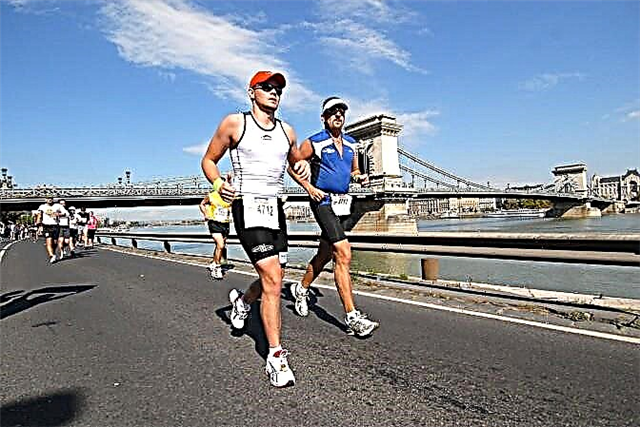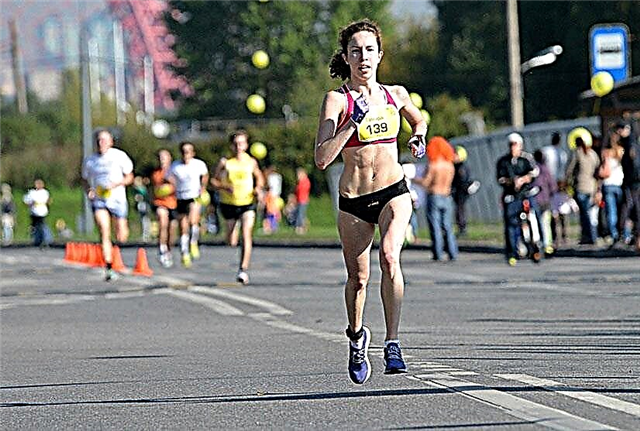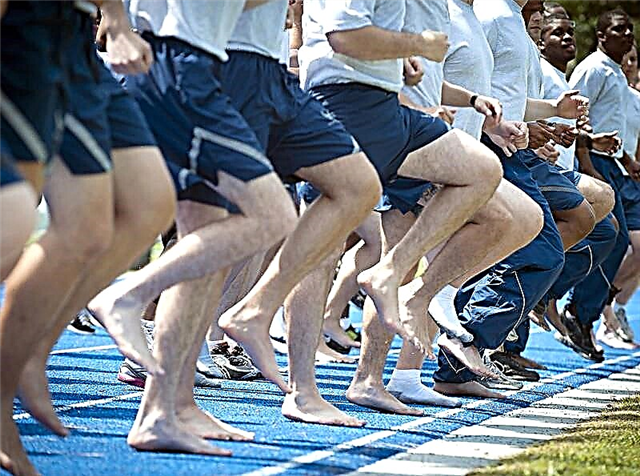One of the first tasks of any novice runner, let alone an experienced athlete, is to find the most comfortable running technique for himself.

Shoulder position
One of the most common mistakes in running is tight shoulders. When running, the shoulders should be relaxed and lowered.

Here is a photo from the 2008 Berlin Marathon, in which the legendary Haile Gebreselassie in a group of pacemakers is running towards his next victory and setting a new world record. Unfortunately, Haile himself is difficult to see in the photograph (he is in the middle in a yellow T-shirt). However, look at other runners. All of them, without exception, have lowered and relaxed shoulders. Nobody squeezes or lifts them.
Another important point is that the shoulders should not rotate. A slight movement of the shoulders, of course, may well be. But just a small one. This movement can be seen in the photo of athlete 85. And from the point of view of ideal running technique, this is no longer correct. If you look closely, then Haile Gebreselassie's shoulders do not move.
Hand technique
The arms should work along the torso so that they do not cross the midline of the torso. The midline is an imaginary vertical line drawn from nose to ground. If the hands cross this line, then the rotational movement of the body cannot be avoided.
And this is another mistake, when the balance of the body is maintained not by synchronizing the work of the arms and legs, but by active rotation of the trunk. In addition to wasting energy, this will not give any benefit.

This photo shows a marathon run at the 2013 World Athletics Championships. Leading group of runners. Notice that none of the athletes have their arms crossing the midline of the torso. At the same time, the work of the hands is slightly different for everyone.
For example, someone has an angle of flexion of the arms at the elbow frankly less than 90 degrees, someone about 90 degrees. There are also options where this angle is slightly larger. All this is not considered a mistake and depends only on the athlete himself and on how it is more convenient for him.
Moreover, while running, you can slightly change this angle during the work of the hands. Some of the leaders of the world distance running run this way.
Another point is the palms. As you can see from the photo, all palms are gathered in a free fist. You can run with your palm extended. But this is not so convenient. Clamping your hands into a fist is not worth it. This is an extra tightness that also takes away strength. But it does not provide any advantage.
Footwork technique
The hardest and most important part of the question.
There are 3 main types of foot positioning for medium and long distance running. And they are all used by professional athletes. Therefore, all these types of foot placement techniques have a right to exist.
Running technique from heel to toe
The first and most common is the heel-to-toe rolling technique. In this case, the heel is first placed on the surface. And then the elastic foot rolls onto the toe, from where the push is made.

Here is a screenshot from the official video of the Moscow Marathon 2015. Leaders' race, in the center - the future winner of the competition Kiptu Kimutai. As you can see, the foot is first placed on the heel, and then rolled onto the toe.
It is very important in this case that the foot is elastic. If you just put your foot on the heel, and then with a relaxed foot "slap" on the asphalt, then your knees will not say "thank you" to you. Therefore, this technique is actively used by professionals. But the elasticity of the foot is important.
Running technique with setting the entire foot to the outer part of the foot
A running technique that is less common than a rolling from heel to toe. However, it is also actively used by professionals.

Let's turn to another screenshot. As you can see on it, the foot of the leg (in the center) is preparing to descend to the surface with the outer part, but at the same time the touch will be made simultaneously with the back and front parts.
In this case, the foot is elastic at the moment of touch. This reduces the shock load on the joints. In addition, from the point of view of efficiency, this positioning of the foot is better than setting the foot by rolling from heel to toe.
Technique rolling from toe to heel
Haile Gebreselassie is deservedly considered the standard of this running technique. He always ran in this way and it was on this technique that he set all his world records.
The technique is very effective, but very difficult to execute. Requires an athlete of colossal leg muscle endurance.

Let's look at a screenshot of one of Haile Gebreselassie's races. As you can see, the leg is first placed on the front of the foot and then lowered to the entire surface.
Due to this method, the leg is ideally placed under the runner's center of gravity, and from the point of view of energy savings, this technique can be called the reference technique. With this method, it is important to learn not to stick your foot into the surface. In this case, the picture will be reversed. Instead of saving energy, there will be their loss. Your foot should be on top and just push you forward.
Many elite runners use different foot positioning techniques when running long distances along the path to engage different muscles periodically. So, for example, part of the distance can be run from toe to heel. Part from heel to toe.

Running on the forefoot
There is another way of placing the foot, when the entire distance is overcome exclusively on the forefoot. But this technique is very difficult to master, and for amateurs it doesn't make much sense to strive to run long distances in this way.
For fans on the forefoot, you need to run no more than 400 meters. Let's say the result of 2.35 per kilometer is quite possible to show the running technique by rolling from heel to toe.
Other basics of running technique
You should have minimal vertical vibrations while running.
Keep running high, meaning your knees shouldn't bend overly. Otherwise it will be a sneaky run that is ineffective.
Try to raise your swing leg hip a little higher. Then the foot is more likely to stand "on top", and there will be no bumping into its own leg.
The angle between the thighs is important. The larger it is, the more effective the run. But the main thing at this point is the angle between the thighs, and not between the shins. If you try to put your whole leg forward, not your hip, you will bump into it with every step and lose speed.
Increase your running frequency. The ideal is the cadence of steps per minute during running from 180. The leaders of the world long distance running have this frequency up to 200. The cadence reduces shock load and makes running more efficient.
Try to run so that your feet are facing the direction of travel. Moreover, ideally, your legs should move in a single line, as if you were running along a narrow curb. In this case, the balance of your body improves and strong gluteal muscles are actively involved in the work. This is how all professional athletes run. Particularly noticeable is the movement along one line among the walkers.

Elastic foot. This is the most important component. If you just flop your foot to the surface, then it doesn't matter in what way you do it, you cannot avoid injuries. Therefore, the foot must be firm. Not clamped, but elastic.
How long does it take to learn running technique
In order to master the technique of running at a level when you no longer think about it, it will take a month, maybe two.
In order to master the technique of rolling from toe to heel, it will take several months, as well as regular training of the lower leg muscles.
Life is not enough to master any running technique perfectly. All professionals constantly practice their running technique at every workout.









